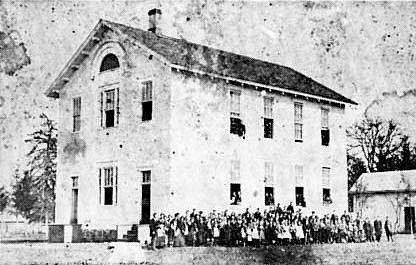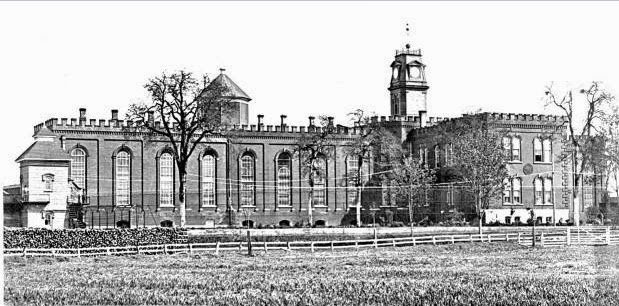World Events
- The Canadian Parliament has its first meeting in Ottawa, its capital city.
- In Sweden, Alfred Nobel, a manufacturer of cannon and other armaments, invents dynamite. Condemned as the “merchant of death”, he bequeathed his fortune to establish the Nobel Prizes for advancement in areas such as culture, science and world peace.
- The Reconstruc
tion begins in Tennessee, the first Confederat e state readmitted to the Union. - The first Civil Rights Act is passed by Congress to affirm that all citizens, including African Americans recently freed from slavery, are equally protected under law.
- Two household products known today have their beginning: Nestle and General Mills.
- The ASPCA is founded in NYC to provide an organization working to protect animals from cruel treatment.
- A new US coin, the “nickel,” is circulated.
In Salem
The first Equal Rights Law, established this year, does not speak of education, but in a prosperous democracy, it is vital. Salem began educating its youth in 1851 when a log cabin on the southwest corner of Marion and Commercial Streets became Salem’s first school, supported mainly by tuition. By 1857 a larger school was needed, and Central School (above) was built by the county near High Street between Center and Marion Streets. By 1859 there were 227 school age children in the district, but there is no record of how many children actually attended school. Ten-year-old T. T. Geer, a future Governor of Oregon from 1899 to 1903, attended Central School in 1861. By 1865 the number of children in the district had grown to 632 with 200 students in attendance at Central School.
By 1866 there are 600 children of school age in Salem, 200 of these crowded into Central. For the photograph above, they leaned out of windows and clustered outside. This year the district levies a 5-mill tax to build two new schools. One was built in north Salem and the second school, South School, as it was named, was originally located at Fir and Myers Streets, but was moved to South Commercial Street in 1892. The school building was later used in turn as a cider mill, machine shop and as the W. A. Barkus Feed Mill. The building existed as late as the 1960s.
These 1866 school buildings do not exist today. In 1906, Central School gave up its site for the new Salem High School. This school was demolished in 1954 for the Meier and Frank Department Store, now Macy’s.Other Events
- The Oregon State Penitentia
ry is moved to Salem with inmates transferre d from Portland to a temporary wooden facility in Salem and set to work manufactur ing bricks for a permanent prison structure. The photograph above was taken in the 1880s when the brick establishment was completed. This building has been replaced by a new, heavily enclosed, buildings on a large property in the 2600 block of State Street. It is adjacent to the Oregon State Hospital with an entrance on Center Street. An instrument used in these early years to restrict prisoners from escaping was the “Oregon Boot,” a weighted shoe to hamper prisoners’ walking. One of these can be seen in an exhibit at Oregon Correction s Enterprise s at 3691 State Street. Call (503) 378-2677 for an appointmen t.
- In this same year, an editorial in the Oregon Statesman called for the establishment of a County infirmary to care for “the aged and infirm who are thrown upon the charities of the world”. A Poor Farm account on a farm near Silverton was set up in 1870.
- New businesses in 1866 include Capitol Lumber on Front Street along the Willamette River (submerged by flood of 1890) and Pioneer Oil on the property that in 1889 would house the Thomas Kay Woolen Mill.Westacott Brewery was established on Commercial Street at the site of the present Meridian Building.
- Individuals chosen to care for the indigent in Salem were often doctors or owners of boarding houses. A contract between Dr. G. W. Brown and Marion County in October of this year stipulates that the doctor would take in any county charges for $4.00 per week. An editorial in the Oregon Statesman called for the establishment of a County Infirmary to care for “the aged and infirm, who are thrown upon the charities of the world.”
- Dr. Daniel Payton, who had moved with his family to Salem in the previous year, organized the medical department of Willamette University. He took the chair of Therapeutics, after wards Obstetrics and Diseases of Women. He held that position for thirteen years and received the honorary distinction of Professor Emeritus. From 1874 and 1875 he was dean of the medical school at Willamette University. In 1878, the Medical Department was moved to Portland, Oregon. Payton retired from active teaching when the Medical Department closed. In that year, his wife Elizabeth died. He continued to conduct his medical practice in Salem until 1883 and devoted his efforts to his newfound specialty, gynecology. He was a distinguished citizen of Salem, serving as director of the Salem public schools for twelve years, Mayor of Salem for one term, and Representative of Marion County in the Oregon State Legislature for one term.



4 Comments